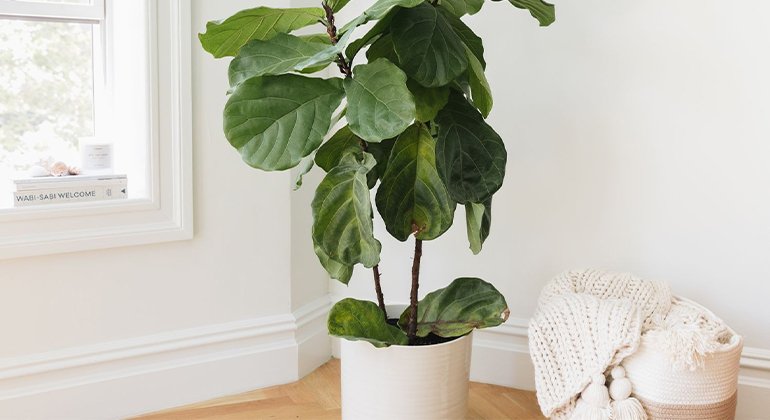
Fiddle leaf figs (Ficus lyrata) sometimes have a finicky reputation. They’re not the easiest houseplant to grow, but their beautiful large leaves and tree shape make them a good choice, even for the novice gardener. These small trees are well adapted to indoor temperatures and filtered light, and are hardy enough to survive less than ideal conditions.
If you have a window that receives bright morning light, you can grow this fig. Plant it in high-quality soil, establish a consistent watering schedule, and it will grow reliably and fairly quickly to a height of 6 to 10 feet without much effort. Fiddle leaf figs are toxic to people and pets.
Fiddle leaf figs grow and look best in bright, indirect light. Direct sunlight can burn the leaves; especially when exposed to the hot afternoon sun.3 Plants adapt to low light, but grow more slowly and may develop brown spots on the lower leaves. Inadequate light can contribute to drainage problems, so plan to adjust the watering schedule in low light conditions.
Any quality houseplant potting soil will work as long as it drains well. A peaty soil mixed with perlite or a 50/50 mix of cactus and houseplant soil will provide good drainage.

Fiddle leaf figs like a moderate amount of moisture in the soil. If the plant doesn’t get enough water, the leaves will wilt and lose their bright green color. If it gets too much water, it can shed leaves and suffer root rot. During the growing season, water your fiddle leaf fig when the top 1 inch of soil feels dry. Water a little less often in winter.
These plants are sensitive to high levels of salt in the soil.4 Salts can build up in clay pots, treated water, and fertilizers. Flush the soil several times a month until water comes out of the bottom drainage holes to prevent salt buildup.
Average household temperatures kept relatively constant between 60 and 85 degrees F are sufficient. Aim for humidity between 30 and 65 percent, and leave some space around your plant for good air circulation. If you need to humidify dry winter air, mist it daily or place the pot on a tray of pebbles filled with water. A small humidifier is a third option.
Fertilize once a month during the growing season with a nitrogen-rich plant fertilizer. An NPK 16-5-11 is a good choice with a ratio of three parts nitrogen to one part phosphorus. You can use water-soluble pellets or liquid fertilizers for houseplants, including special formulas for fiddle leaf figs. Water your plant well beforehand and stop feeding fertilizer during the winter months.
The most commonly grown fiddle leaf fig is the main species, Ficus lyrata, but several cultivars are available, including:
Ficus lyrata ‘Bambino’: A dwarf variety that only grows a few feet tall.
Ficus lyrata ‘Compacta’: This variety grows up to 5 feet tall and features smaller, denser leaves.
Ficus lyrata ‘Variegata’: An unusual variety with a striking mix of green and cream leaves.

Fiddle leaf figs benefit from occasional, selective pruning. Do this in late spring or summer when the plant is actively growing. Use sturdy, sharp pruning shears and cut at a 45-degree angle between the leaf nodes, being careful not to damage a branch or the main trunk.
Some growers prefer a tree-like appearance with a branched crown. Experienced growers recommend waiting to begin this process until your fiddle leaf reaches 5 feet tall. Then, cut the main stem above a leaf node to encourage branching. Once new branches begin to form, additional cuts can be made to encourage horizontal growth.
Removing dead leaves or trimming damaged leaves can be done at any time. Dead leaves can often be gently pulled off. Brown edges can be trimmed off if the majority of the leaf remains healthy and green. Follow the shape of the leaf for a more natural look.
Fiddle leaf figs are easily propagated using stem cuttings rooted in either soil or water. The process is essentially the same for either medium. For propagation in water, you will need sturdy garden shears, rooting hormone, and a clear glass container.
Using sharp garden shears, cut a branch with at least three leaf nodes. Make the cut at a 45-degree angle just above a node.
Pinch off the lower leaves, but leave one or two on top.
Dip the cutting in rooting hormone to cover the lower nodes, or add a propagation accelerator to room temperature water in a clean glass vase or jar.
Place the cutting in water with the nodes submerged and the leaves above the water line. The upper leaves can be cut in half to direct energy into root development.
Place the cutting in a warm location with bright, indirect light.
Change the water weekly. Roots will appear after two to three weeks.
Let the cuttings continue to grow in the water until several roots are 1 to 2 inches long.
Plant the cutting in a 1-gallon pot with drainage holes.
To root cuttings in soil, start with steps 1 and 2 listed above. Dip the bottom in rooting hormone and place in a pot with well-draining potting soil. A pot at least 6 inches in diameter with drainage holes is usually sufficient.
Firm soil so the cutting stands upright and cover with a plastic bag. Place in a warm location with bright, indirect light. After two weeks, check to see if roots have grown by gently tugging on the cutting. Resistance indicates success.
Plan to repot a young fiddle leaf fig each spring. Choose a sturdy container about 2 inches larger in diameter than the existing one. Carefully loosen the plant from its current pot, lift it out while holding it by the bottom, and place it in the new pot. Backfill the area around the plant with potting soil.
When mature plants are too large to repot, remove the top few inches of soil each spring and replace it with fresh soil.